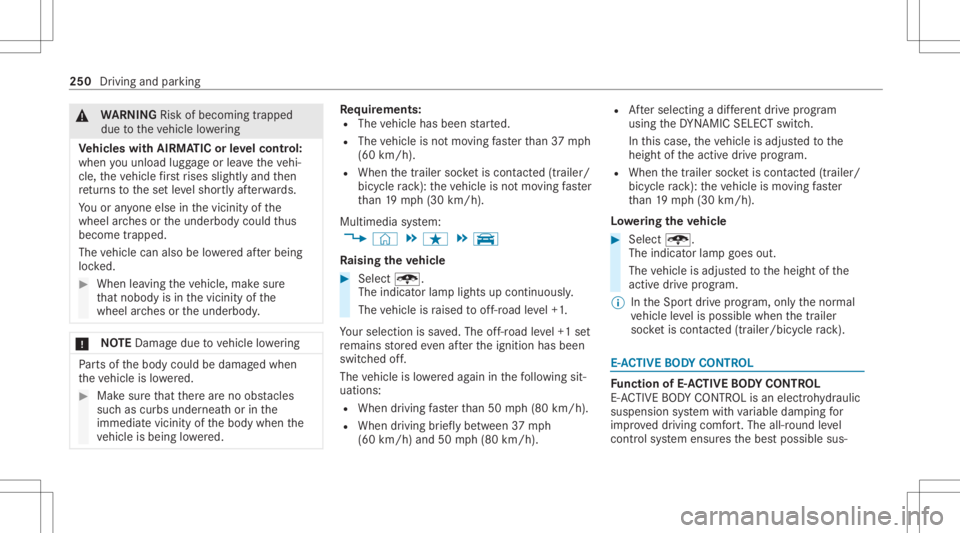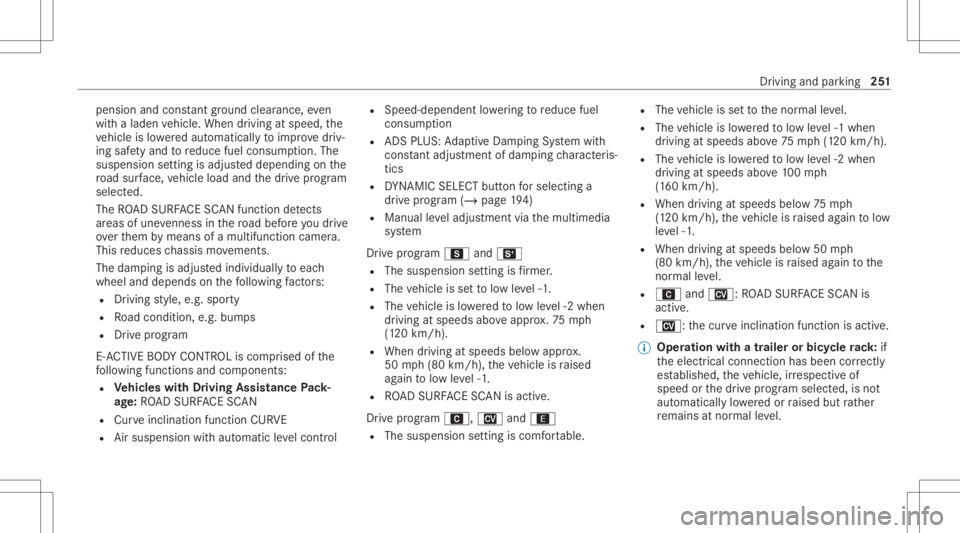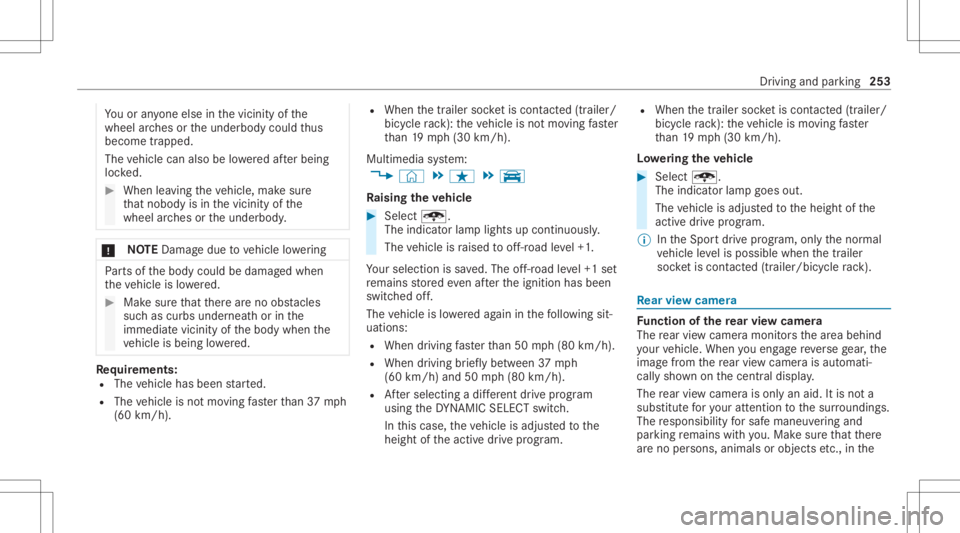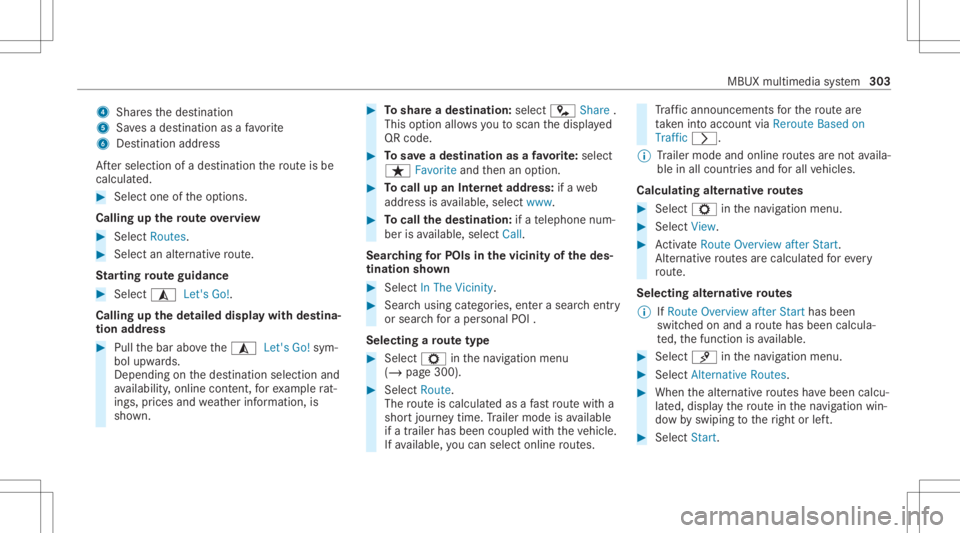2022 MERCEDES-BENZ S CLASS trailer
[x] Cancel search: trailerPage 225 of 610

Obser
vetheno teson driving systems andyour
re sponsibili ty;yo uma yot her wise failto recog‐
nize dangers(/ page 210).
Sy stem limit s
The system limits ofTraf fic Sign Assistappl yto
th ede tection oftraf fic sig ns (/ page 236) .
Speed limitsbel ow 12mp h(20 km/h) areno t
aut omaticall yadop tedby thesy stem asthe
st or ed speed. Temp oraryspeed restrictions (e.g.
fo ra cer tain tim eor due towe ather condition s)
can notbe proper lyde tected bythesy stem. The
maximum permissible speedapplying toave hi‐
cle withatrailer isno tde tected bythesy stem.
Ad jus tth espeed inthese situation s. &
WARNIN GRisk ofacci dent dueto Active
Spe edLimi tAssi stadap tingth eve hicle's
speed
The speed adoptedby ActiveSpe edLimi t
Assi stma ybe toohigh orincor rect insome
indi vidualcase s,su ch as:
R atspee dlimit sbelo w12 mp h(20 km/h) R
inwe tcond itions orinfog
R when towing atrailer #
Ensur eth at thedr iven speed complies
wit htraf fic re gulations. #
Adjus tth edr iving speed tosuit current
tr af fic and weather condition s. Fu
nction ofrout e-base dspee dadap tation
When ActiveDis tance AssistDIS TRONI Cis acti ‐
va ted, theve hicle speed willbeadap tedaccor d‐
ing lyto thero uteev ent sahead. Dependingon
th edr ive pr og ram sele cted, theve hicle negoti‐
at es aro uteeve ntaheadin afue l-saving, com ‐
fo rtable ordynam icman ner.When thero ute
eve nthasbe en passe d,theve hicle acceler ates
ag ain tothestor ed speed. Thesetdis tance to
th eve hicle infront, vehicles detected aheadand
spe edrestrictions aheadar eta ke nint oacco unt.
Ro ute-based speedadap tatio ncan beacti vated
in themultimedia system (/ page22 4).
The follo wing routeeve nts areta ke nint o
acco unt:
R Curves R
Round about s
R T-int ersect ions
R Turnsand exits
R Traf fic jams ahead(only with Liv eTr af fic )
Also ,th espeed isreduced ifth etur nsignal indi‐
cat orisswitc hedonand one ofthefo llo wing sit‐
uation sis de tected:
R Turning offat intersect ions
R Drivin gon slowing- down lanes
R Drivin gon lanes adjacenttoslo wing-do wn
lanes
The driver isresponsible forch oosing theright
speed andobser vingother road user s.This
applies inpar ticular tointersect ions,ro und ‐
about sand traffic lights, asroute-based speed
adap tatio ndo es notbr ak eth eve hicle toast and‐
st ill.
If acor responding routeeve ntisde tected whi le
ro uteguidan ceisact ive, thefirs tsp ee dad jus t‐
ment iscar ried out automatic ally.If th etur nsig‐
nal indicat orisswitc hedon,theselect edrouteis Dr
ivin gand parking223
Page 252 of 610

&
WARNIN GRisk ofbeco ming trap ped
du eto theve hicle lowe ring
Ve hicl eswith AIRMA TICorleve lcontr ol:
when youunlo adlugg ageor lea vetheve hi‐
cle, theve hicle firs trises slightly andthen
re tur ns tothese tle ve lshor tly af te rw ards.
Yo uor anyone else inthevicinit yof the
wheel arch es ortheunderbody couldthus
bec ome trapped.
The vehicle canalso belowe redaf te rbeing
loc ked. #
When leaving theve hicle, makesur e
th at nobody isin thevicinit yof the
wheel arch es ortheunderbody . *
NO
TEDama gedue tovehicle lowe ring Pa
rts of thebody could bedamag edwhen
th eve hicle islowe red. #
Mak esur eth at ther ear eno obs tacles
suc has curbs underneathor inthe
immed iatevicin ityofthebody when the
ve hicle isbeing lowe red. Re
quirement s:
R The vehicle hasbeen star ted.
R The vehicle isno tmo ving faster than 37 mph
(60 km/ h).
R When thetrailer socketis cont acted (traile r/
bi cy cle rack ):th eve hicle isno tmo ving faster
th an 19 mp h(3 0km/h).
Mul timedi asy stem:
4 © 5
ß 5
y
Ra ising theve hicl e #
Select t.
The indica torlam plig hts upcontinuous ly.
The vehicle israised tooff-r oad leve l+1 .
Yo ur sele ction issave d. The off-r oad leve l+1 set
re mains stor ed eve naf te rth eignition hasbeen
switc hedoff.
The vehicle islowe redag ain inthefo llo wing sit‐
uation s:
R When drivin gfa ster than 50 mph(80 km/h).
R When driving brief lybe tween 37mph
(60 km/ h)and 50mph(80 km/h). R
Aftersele cting adif fere nt drive pr ogr am
us ing theDY NA MIC SELE CTswitc h.
In this case, theve hicle isadjus tedto the
height oftheactiv edr ive pr ogr am.
R When thetra iler socketis cont acted (traile r/
bi cy cle rack ):th eve hicle ismo ving faster
th an 19 mp h(30 km/h).
Lo we ring theve hicl e #
Select t.
The indica torlam pgoes out.
The vehicle isadjus tedto theheight ofthe
act ive dr ive pr ogram.
% IntheSpor tdr ive pr ogr am, onlyth enor mal
ve hicle leve lis possible whenthetra iler
soc ketis cont acted(traile r/b icycle rack ). E-
AC TIVE BODY CONT ROL Fu
nction ofE-AC TIVE BODY CONT ROL
E- AC TIVE BODY CONTR OLisan electr ohydr aulic
suspe nsion system withva riable dampingfo r
im prov ed driving comfort.The all-round leve l
contr olsystem ensur esthebes tpossible sus‐ 250
Driving andparking
Page 253 of 610

pension
andconstant groun dcle aranc e,eve n
wit haladen vehicle. When driving atspeed, the
ve hicle islowe redaut omatic allytoimprove driv‐
ing safetyand toreduce fuelconsum ption. The
suspen sionsetting isadjus teddependin gon the
ro ad sur face, vehicle loadandthedr ive pr ogr am
select ed.
The ROAD SUR FACE SCAN function detects
ar ea sof une venness inthero ad bef oreyo udr ive
ove rth em bymeans ofamultifu nctioncamera.
This reduces chassis movements.
The dam ping isadju sted individually toeac h
wheel anddepends onthefo llo wing fact or s:
R Driving style, e.g. spor ty
R Road con dition ,e.g .bum ps
R Drive pr ogram
E- AC TIVE BODY CONTR OLiscom prised ofthe
fo llo wing functionsand compone nts:
R Vehicl eswith Drivin gAss istanc ePa ck‐
ag e:RO AD SUR FACE SCAN
R Cur veinc linat ionfunc tion CURVE
R Airsuspen sionwithaut omat icleve lcon trol R
Speed -dependentlo we ring toreduce fuel
con sum ption
R ADSPL US: AdaptiveDam pingSy stem with
con stant adjus tment ofdam pingch aract eris‐
tic s
R DYNA MIC SELE CTbutt onforsele cting a
dr ive pr ogr am (/ page19 4)
R Manua lle ve ladjus tment viathemultimedia
sy stem
Dr ive pr og ram C andB
R The susp ension setting isfirm er.
R The vehicle issetto low leve l-1 .
R The vehicle islowe redto low leve l-2 when
dr ivin gat speeds aboveappr ox.75 mph
(1 20 km/ h).
R When driving atspeeds belowappr ox.
50 mph(80 km/h), theve hicle israised
ag ain tolow leve l-1 .
R ROAD SUR FACE SCAN isact ive.
Dr ive pr og ram A, Nand;
R The susp ension setting iscomf ortable. R
The vehicle issetto thenor mal leve l.
R The vehicle islowe redto low leve l-1 when
dr ivin gat speeds above75 mph(120 km/h).
R The vehicle islowe redto low leve l-2 when
dr ivin gat speeds above100mp h
(1 60 km/ h).
R When driving atspeeds below75 mph
(1 20 km/ h),theve hicle israised again tolow
le ve l-1 .
R When drivin gat speeds below50 mph
(80 km/ h),theve hicle israised again tothe
nor malle ve l.
R A andN: ROAD SUR FACE SCAN is
act ive.
R N: thecur veinc linat ionfunc tion isact ive.
% Oper ation withatrailer orbicy clerack :if
th eelectr icalconnect ionhas been correctly
es tablished, theve hicle, irre spectiv eof
speed orthedr ive pr og ram sele cted, isno t
au tomatical lylowe redor raised butrath er
re mains atnor mal leve l. Dr
ivin gand parking 25
1
Page 255 of 610

Yo
uor anyone else inthevicinit yof the
wheel arch es ortheunderbody couldthus
bec ome trapped.
The vehicle canalso belowe redaf te rbeing
loc ked. #
When leaving theve hicle, makesur e
th at nobody isin thevicinit yof the
wheel arch es ortheunderbody . *
NO
TEDama gedue tovehicle lowe ring Pa
rts of thebody could bedamag edwhen
th eve hicle islowe red. #
Mak esur eth at ther ear eno obs tacles
suc has curbs underneathor inthe
immed iatevicin ityofthebody when the
ve hicle isbeing lowe red. Re
quirement s:
R The vehicle hasbeen star ted.
R The vehicle isno tmo ving faster than 37 mph
(60 km/ h). R
When thetrailer socketis cont acted (traile r/
bi cy cle rack ):th eve hicle isno tmo ving faster
th an 19 mp h(3 0km/h).
Mul timedi asy stem:
4 © 5
ß 5
y
Ra ising theve hicl e #
Select t.
The indica torlam plig hts upcontinuous ly.
The vehicle israised tooff-r oad leve l+1 .
Yo ur sele ction issave d. The off-r oad leve l+1 set
re mains stor ed eve naf te rth eignition hasbeen
switc hedoff.
The vehicle islowe redag ain inthefo llo wing sit‐
uation s:
R When drivin gfa ster than 50 mph(80 km/h).
R When driving brief lybe tween 37mph
(60 km/ h)and 50mph(80 km/h).
R Aftersele cting adif fere nt drive pr ogr am
us ing theDY NA MIC SELE CTswitc h.
In this case, theve hicle isadjus tedto the
height oftheactiv edr ive pr ogr am. R
When thetra iler socketis cont acted (traile r/
bi cy cle rack ):th eve hicle ismo ving faster
th an 19 mp h(30 km/h).
Lo we ring theve hicl e #
Select t.
The indica torlam pgoes out.
The vehicle isadjus tedto theheight ofthe
act ive dr ive pr ogram.
% IntheSpor tdr ive pr ogr am, onlyth enor mal
ve hicle leve lis possible whenthetra iler
soc ketis cont acted (traile r/b icycle rack ). Re
ar vie wcamer a Fu
nction ofthere ar vie wcamer a
The rear vie wcam eramon itor sth ear ea behind
yo ur vehicle. When youen gage reve rsege ar,th e
imag efrom there ar vie wcam erais aut omat i‐
call ysho wnonthecent raldispla y.
The rear vie wcam erais on lyan aid. Itis no ta
subs titutefo ryo ur att entio nto thesur round ings.
The responsibili tyforsaf emaneu vering and
pa rking remains withyo u. Mak esur eth at ther e
ar eno per sons, animals orobjec tsetc., inthe Dr
iving and parking 253
Page 305 of 610

4
Sharesth edes tinat ion
5 Savesa des tination asafa vo rite
6 Destinationad dress
Af tersele ction ofades tination thero uteis be
calc ulated. #
Select oneof theop tion s.
Calling upthero ut eove rview #
Selec tRoutes. #
Selec tan alternat ive ro ute.
St arting rout eguidanc e #
Select ¥Let'sGo!.
Call ingupthede tailed displaywit hdes tina ‐
tion address #
Pull thebar abovethe¥ Let'sGo!sym‐
bol upw ards.
Depen dingonthedes tinat ionselect ionand
av ailabilit y,online content, forex am ple rat‐
ing s,price sand weather informat ion,is
sho wn. #
Toshar eades tinat ion:select ÇShare .
This option allowsyouto scan thedispla yed
QR code . #
Tosave ades tinatio nas afa vo rite :sel ect
ß Favoriteand then anoption . #
Tocall upanInterne tad dress: ifawe b
addr essisavailable, selectwww . #
Tocall thedes tina tion: ifate lephon enum‐
ber isavailable, selectCall .
Sear ching forPO Isin the vicini ty of the des‐
tin atio nsho wn #
Select InThe Vicini ty. #
Sea rchusing categor ies,enterasear chent ry
or sear chfora per sonal POI.
Sel ecti ngaro ut etype #
Select Zinthena vig ation menu
(/ page300). #
Select Route.
The routeis calc ulatedasafa st routewit ha
sho rtjou rney tim e.Trailer mode isavailable
if atrailer hasbeen coupledwithth eve hicle.
If av ailable, youcan selectonlinero utes. Tr
af fic annou ncements forth ero utear e
ta ke nint oacco untviaRerou teBas edon
Tra ffic0048.
% Trailer mode andonline routes areno tav aila‐
ble inall coun tries and forall vehicles.
Calculating alternativ ero ut es #
Select Zinthena vig ation menu. #
Select View. #
ActivateRo ute Ove rview after Star t.
Alt ernati veroutes arecalc ulatedforev ery
ro ute.
Select ingalternat ive ro utes
% IfRou teOvervie wafter Start hasbeen
swi tched onand aro utehas been calcula‐
te d, thefunc tion isavailable. #
Select ¡ inthena vig ation menu. #
Select Alternativ eRoutes. #
When thealt ernativ ero utes have been calcu‐
lat ed, displa yth ero utein thena vig ation win‐
do wby swiping totheright orleft. #
Select Start. MBUX
multimedia system 303
Page 362 of 610

To
wing eyesto rage location To
wing eye1 islocat edunder thetrunk floor .
Depending ontheve hicle equipment, theto wing
ey ema ybe locat edatano ther position inthe
tr unk . In
stalli ng theto wing eye #
Press themar kon cover1 inwa rdsand
re mo ve. #
Screw intheto wing eyecloc kwiseasfaras it
wil lgo and tight en. #
Mak esur eth at cover1 eng ages inthe
bum perwhen youre mo vetheto wing eye. *
NO
TEDama getotheve hicle dueto
inc orrect useof theto wing eyeor tra iler
hitc h When
ato wing eyeor tra iler hitchis used to
re co vera ve hicle, theve hicle maybe dam‐
ag ed inthepr ocess. #
Onlyuse theto wing eyeor trailer hitch
to tow aw ay ortow star tth eve hicle. #
Donotuse theto wing eyeor tra iler
hitc hto tow theve hicle during reco very. To
w- star ting theve hicl e(eme rgency engine
st ar t) *
NO
TEDama getotheaut omatic trans‐
mission duetotow- star tin g To
w- star tin gth eve hicle candamag eth e
aut omat ictransm ission. #
Donotto w- star tth eve hicle. #
Donotto w- star tth eve hicle. 360
Breakdo wnassis tance
Page 376 of 610

ble
cargoand luggageload capacit ycalcula‐
te din Step 4. #
(6): Ifyo ur vehicle willbetowing atrailer ,
load from your trailer willbetrans ferred to
yo ur vehicle. Consult this manual todeter‐
mine howthis reduces theav ailable cargo
and luggageload capac ityofyour vehicle.
% Notall vehicles areper mitt edtotow a
trailer .To wing atrailer isonl yper mittedifa
tra iler -hit chisins talled. Please consult an
aut hor ized Mercedes -Benz dealer ifyo uha ve
an yqu estion sabout towing atrailer with
yo ur vehicle.
Ev en ifyo uha ve cal cul ated thetot alload care‐
full y,yo usho uld still mak esur eth at themaxi‐
mum permissible gross weight andthemaxi‐ mum
gross axle weight rating ofyour vehicle are
no texc eeded. Details can befound ontheve hi‐
cle identif ication plate. #
Have your loaded vehicle –including driver ,
occupants andload –we ighed onave hicle
we ighbr idge.
The measur edvalues mayno texc eed the
maximu mper missi blevalues stat ed on the
ve hicle identif ication plate.
Fu rther relat ed subje cts:
R Calculation exam ple forde term inin gth emax‐
imum load(/page37 4)
R Tire and Loadi ngInfo rm atio nplacar d
(/ page37 2)
R Tire pressur eta ble (/ page368 ) R
Vehicle identif ication plate(/ page48 4) Calculation
exam ple forde term ining the
ma ximum load The
follo wing table showsexam ples ofhowto
cal cul ateto ta land load capac itieswithva rying
seatin gcon figur ations anddiffere nt num bers
and sizes ofocc upant s.The follo wing exam ples
use amax imum loadof1500 lbs (680 kg).This
is forillus tratio npur pos esonly.Mak esur e
yo uar eusin gth eactual loadlimit foryo ur vehi‐
cle stat ed on your vehicle's Tire and Loadi ng
In fo rm atio nplacar d(/ page37 2).
Th ehigh er thewe ight ofall theoccupant s,the
smaller themaximum loadforlug gage .
Ste p1 Ex
am ple 1E xamp le2
Combine dmaxim umweight ofocc upant sand
load (datafrom theTire and Loadi ngInfo rm atio n
placar d) 15
00 lbs (680 kg)1 500lbs(680 kg) 37
4
Wheels andtires
Page 384 of 610

Un
ifor m Tire Quality Grading Standar ds:a
unif orm standar dto grade thequ alit yof tires
wit hre ga rd totrea dqu alit y,tiretracti onand
te mp eratur ech aract eristic s.The qualit ygr adin g
asses smentismade bythemanuf acturerfollo w‐
ing spec ificat ions from theU. S. government. The
qu alit ygr ade ofatir eis im print ed on theside
wa llof thetir e.
Re comm endedtir epr essu re:th ere comme n‐
ded tirepr ess ureis thetir epr essur especif ied
fo rth etir es mount edtotheve hicle atthefa c‐
to ry.
The tireand information table con tains there c‐
omme ndedtirepr ess ures forcold tires, themax‐
imum permissible loadandthemaximum per‐
missible vehicle speed.
The tirepr essur eta ble con tains there comme n‐
ded tirepr ess ures forcold tires under various
oper ating condit ions,i.e.loading and/orspeed
of theve hicle.
Incr eased vehicl ewe ight duetooptiona l
eq uip ment :th ecombin edweight ofall standar d
and optio nal equipme ntavailable forth eve hicle, re
ga rdless ofwhe ther itis actually installed on
th eve hicle ornot.
Rim: thepar tof thewheel onwhic hth etir eis
ins talled.
GA WR (Gross AxleWe ight Ratin g):th eGA WR
is themaximum permissible axleload. The
actual loadonanaxle mustne verexc eed the
gr os saxle weight rating .The gross axlewe ight
ra ting canbefound ontheve hicle identif ication
plat eon theB‑pillar onthedr iver's side.
Speed ratin g:thespeed rating ispa rtof thetir e
identif ication .It specif iesthespeed rang efo r
whic hatir eis appr oved.
GV W(Gr oss Vehicl eWe ight ):th egr oss vehicle
we ight comprises thewe ight oftheve hicle
including fuel,tools, thespar ewheel, accesso‐
ri es installed, occupant s,lugg ageand thetrailer
dr aw bar nose weight ,if applicable. Thegros s
ve hicle weight mustno texc eed thegr oss vehicle
we ight rating GVWR asspecif iedontheve hicle
identif ication plateon theB‑pillar onthedr iver's
side.
GV WR (Gross Vehicl eWe ight Ratin g):th e
GV WR isthemaximum permitt edgross weight of
thefully laden vehicle (weight oftheve hicle
including allaccessor ies,occupants, fuel,lug‐
ga ge and thetrailer draw bar nose weight ifappli‐
cable). Thegros sve hicle weight rating issp eci ‐
fi ed on theve hicle identif ication plateon the
B‑pil laron thedr iver's side.
Maxim umweight ofthelad envehicl e:the
maximu mwe ight isthesum ofthecurb weight
of theve hicle, thewe ight oftheaccessor ies,the
maximu mloa dand thewe ight ofoption aleq uip‐
men tins talled atthefa ct or y.
Kilop ascal(kP a):metric unit fortir epr essu re.
6.9 kPacor responds to1psi .Ano ther unit for
tir epr es su re isbar .10 0kilop ascal(kP a)equals
1 bar .
Lo ad inde x:inadd ition totheload-bear ing
inde x,theload indexma yalso beimprint ed on
th eside wallof thetir e. This specif iestheload-
bear ingcapacity ofthetir emor epr ecisel y.
Cur bwe ight :th ewe ight ofave hicle withstand‐
ar deq uipme ntinc ludin gth emaximum capacity
of fuel, oiland coolant .It also includes theair
con ditionin gsy stem and option aleq uipment if 382
Wheels andtires